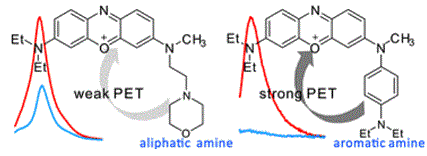Xiu-Li Wang Xiao-Jun Li Ru Sun Yu-Jie XuJian-Feng Ge
a College of Chemistry, Chemical Engineering and Material Science, State and Local Joint Engineering Laboratory for Novel Functional Polymeric Materials, Soochow University
b School of Radiation Medicine and Protection, Medicine College of Soochow University
c Jiangsu Key Laboratory of Medical Optics, Suzhou Institute of Biomedical Engineering and Technology, Chinese Academy of Sciences
Analyst, 2016,141, 2962-2969
In this paper, phenoxazinium was used as a fluorophore for the design of pH probes by the photoinduced electron transfer (PET) mechanism. Phenoxazinium with an aliphatic morpholinyl group (probe 1a) gave increased emission at 665 nm with pH ranging from 7.4 to 4.4; meanwhile, the other one with an aromatic diethylaminophenyl group (probe 1b) gave nearly OFF–ON emission at 679 nm with pH ranging from 7.4 to 4.2. They both were reversible pH probes with good selectivity. Their optical properties, especially the PET mechanism, were illustrated by (TD)DFT theory. Fluorescence confocal imaging of probes 1a–b and a typical phenoxazinium dye (Oxazine 1) was also performed, and the results indicated that probes 1a–b are lysosome-targetable biomarkers.

链接://pubs.rsc.org/en/Content/ArticleLanding/2016/AN/C6AN00258G#